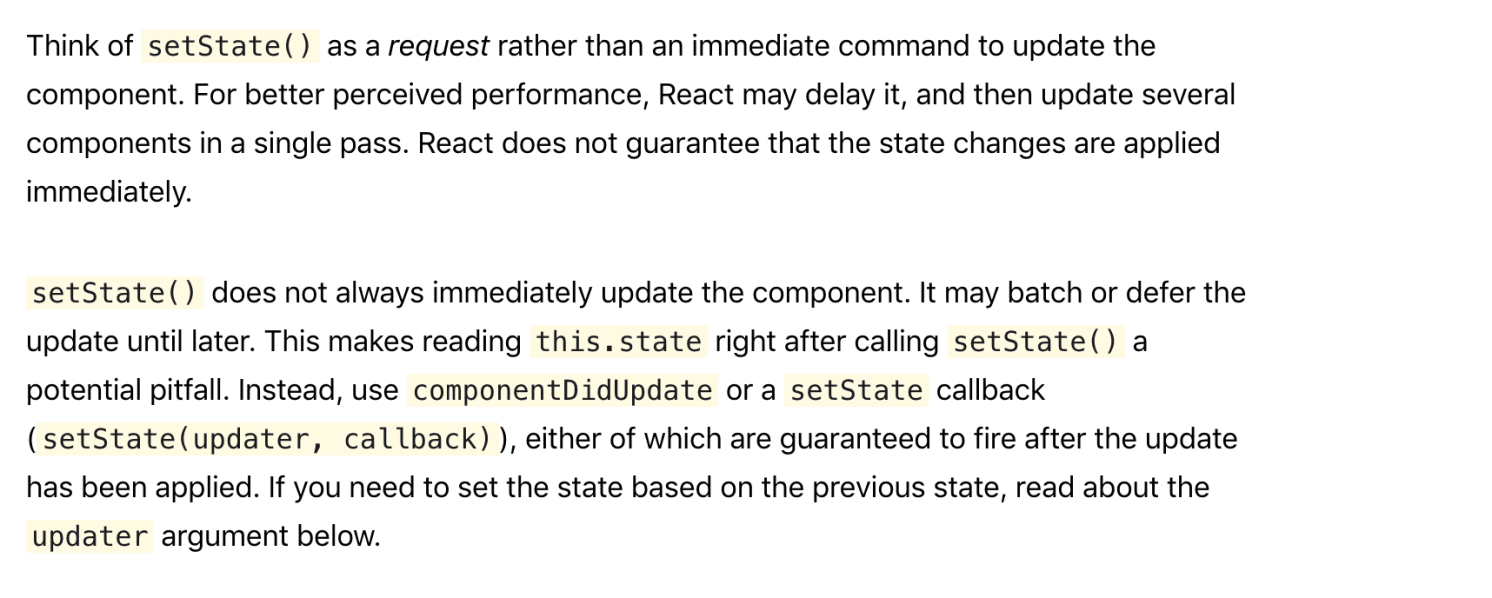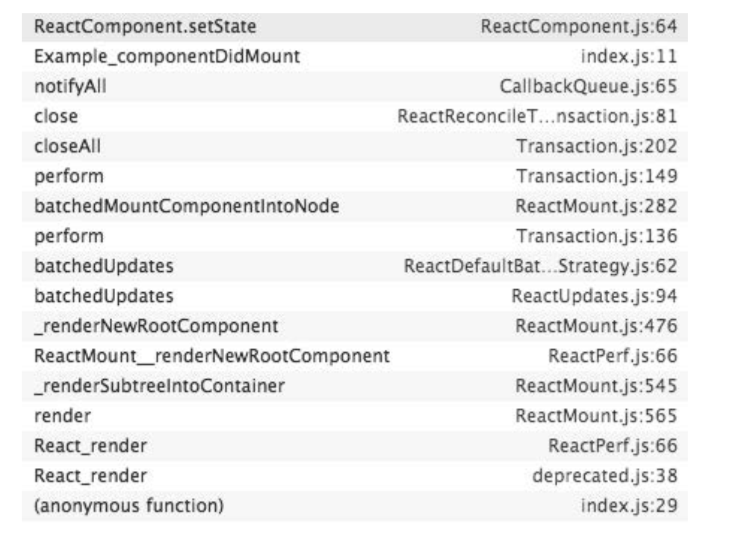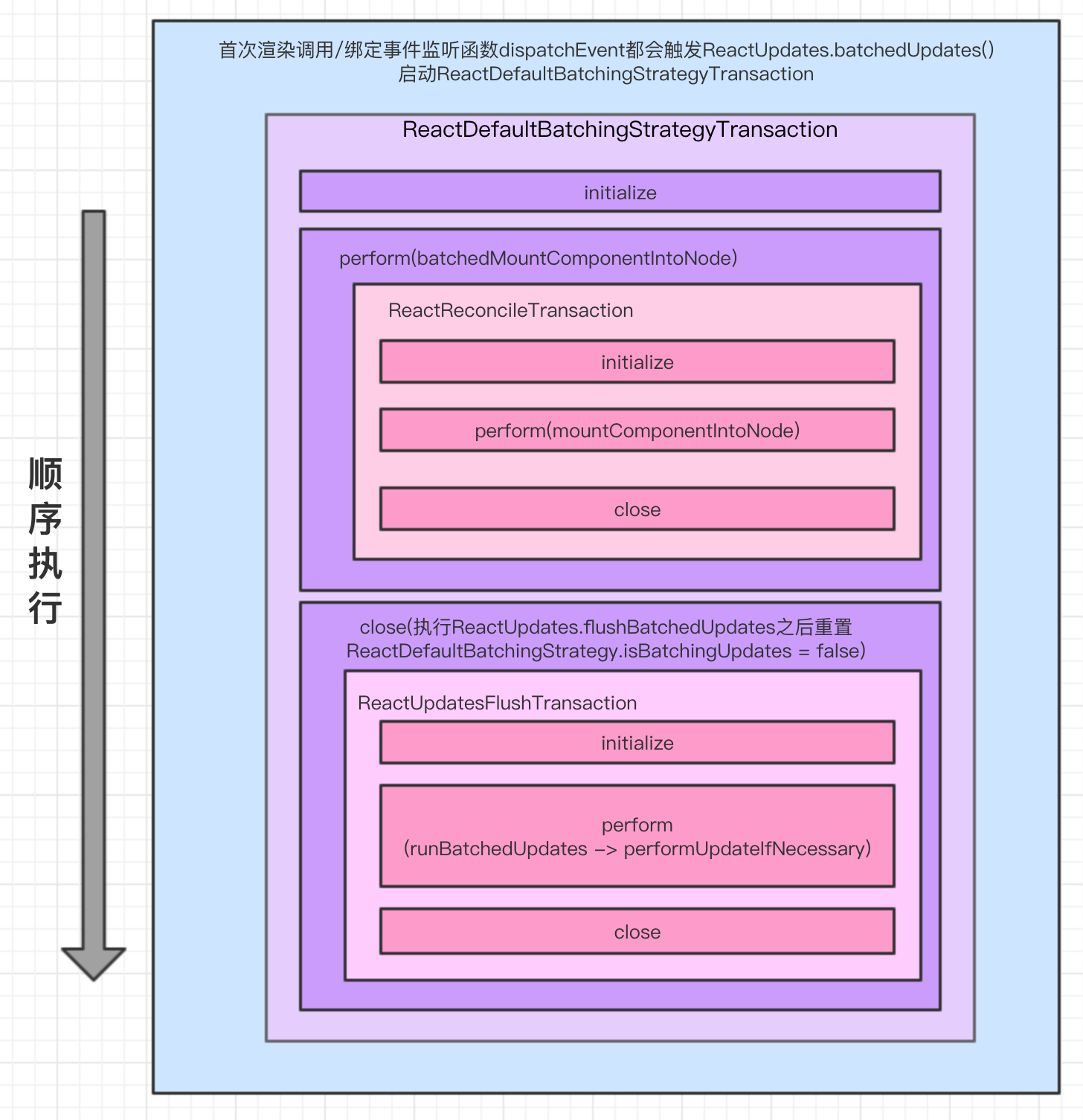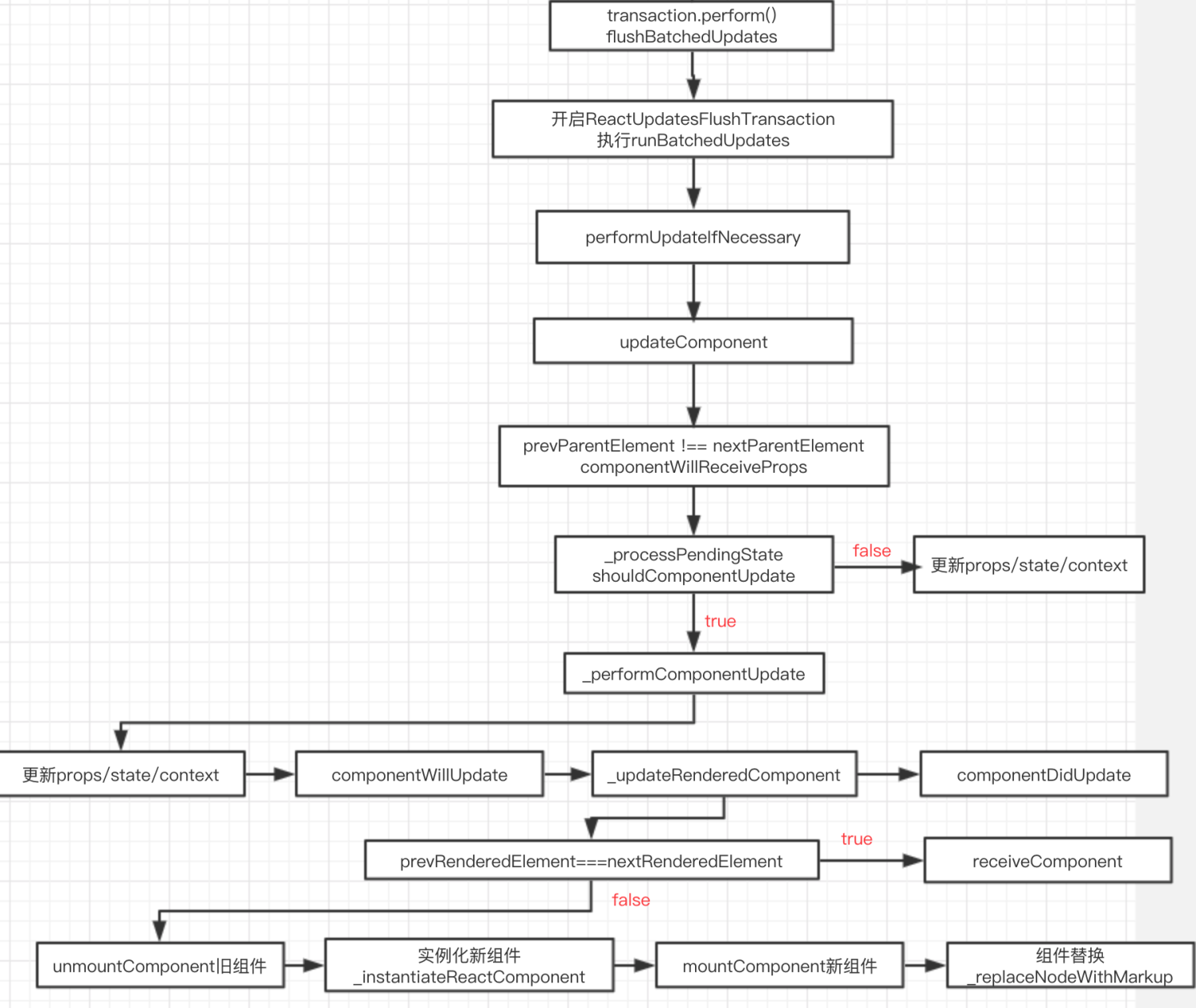本文转载自:微信公众号 方凳雅集
写在前面的话
setState是React很重要的模块, 社区中也有很多分析文章,大多强调setState是异步更新,但有些文章分析又说某些情况下是同步更新,那到底是同步还是异步呢,这篇文章还是基于15.x进行的分析,16.x的分析等后面用机会再分享。
我们看一下React官网对setState的说明:

官网也没说setState到底是同步还是异步,只是说React不保证setState之后能够立即拿到改变后的结果。
Demo
// demo.js
class Demo extends PureComponent {
state={
count: 0,
}
componentDidMount() {
console.log('pre state', this.state.count);
this.setState({
count: this.state.count + 1
});
console.log('next state', this.state.count);
//测试setTimeout
setTimeout(() => {
console.log('setTimeout pre state', this.state.count);
this.setState({
count: this.state.count + 1
});
console.log('setTimeout next state', this.state.count);
}, 0);
}
onClick = (event) => {
// 测试合成函数中setState
console.log(`${event.type} pre state`, this.state.count);
this.setState({
count: this.state.count + 1
});
console.log(`${event.type} next state`, this.state.count);
}
render() {
return <button onClick={this.onClick}>count+1</button>
}
}这里有三种方法调用setState:
- 在componentDidMount中直接调用setState;
- 在componentDidMount的setTimeout方法里调用setState;
- 在dom中绑定onClick(React的合成函数:抹平不同浏览器和端的差异)直接调用setState;

从控制台打印出来的结果看,方法1和3直接调用setState是异步的,而方法2中setTimeout调用setState证明了同步,到底为什么呢?这两种调用方式有什么区别嘛?接下来我们从源码进行分析。
源码分析
setState入口函数
//ReactComponent.js
ReactComponent.prototype.setState = function (partialState, callback) {
!(typeof partialState === 'object' || typeof partialState === 'function' || partialState == null) ? "development" !== 'production' ? invariant(false, 'setState(...): takes an object of state variables to update or a ' + 'function which returns an object of state variables.') : invariant(false) : undefined;
if ("development" !== 'production') {
"development" !== 'production' ? warning(partialState != null, 'setState(...): You passed an undefined or null state object; ' + 'instead, use forceUpdate().') : undefined;
}
this.updater.enqueueSetState(this, partialState);
if (callback) {
this.updater.enqueueCallback(this, callback);
}
};
//ReactUpdateQueue.js
enqueueSetState: function(publicInstance, partialState) {
// 根据 this.setState 中的 this 拿到内部实例, 也就是组件实例
var internalInstance = getInternalInstanceReadyForUpdate(
publicInstance,
'setState'
);
if (!internalInstance) {
return;
}
//取得组件实例的_pendingStateQueue
var queue =
internalInstance._pendingStateQueue ||
(internalInstance._pendingStateQueue = []);
//将partial state存到_pendingStateQueue
queue.push(partialState);
//唤起enqueueUpdate
enqueueUpdate(internalInstance);
};
...
function enqueueUpdate(internalInstance) {
ReactUpdates.enqueueUpdate(internalInstance);
}在setState函数中调用enqueueSetState, 拿到内部组件实例, 然后把要更新的partial state存到其_pendingStateQueue中,至此,setState调用方法执行结束,接下来是setState调用之后的动作。
调用 setState 后发生了什么?
setState调用之后执行方法enqueueUpdate
//ReactUpdates.js
function enqueueUpdate(component) {
//注入默认策略,开启ReactReconcileTransaction事务
ensureInjected();
// 如果没有开启batch(或当前batch已结束)就开启一次batch再执行, 这通常发生在异步回调中调用 setState
//batchingStrategy:批量更新策略,通过事务的方式实现state的批量更新
if (!batchingStrategy.isBatchingUpdates) {
batchingStrategy.batchedUpdates(enqueueUpdate, component);
return;
}
// 如果batch已经开启,则将该组件保存在 dirtyComponents 中存储更新
dirtyComponents.push(component);
}上面demo对setState三次调用结果之所以不同,应该是这里的判断逻辑导致的:
- 1和3的调用走的是isBatchingUpdates === true分支,没有执行更新操作;
- 2的setTimeout走的是isBatchingUpdates === false分支,执行更新;
isBatchingUpdates是事务batchingStrategy的一个标记,如果为true,把当前调用setState的组件放入dirtyComponents数组中,做存储处理,不会立即更新,如果为false,将enqueueUpdate作为参数传入batchedUpdates方法中,在batchedUpdates中执行更新操作。
可是事务batchingStrategy到底是做什么的呢?batchedUpdates又做了什么处理?我们看一下它的源码
//ReactDefaultBatchingStrategy.js
var transaction = new ReactDefaultBatchingStrategyTransaction();// 实例化事务
var ReactDefaultBatchingStrategy = {
isBatchingUpdates: false,
batchedUpdates: function(callback, a, b, c, d, e) {
var alreadyBatchingUpdates = ReactDefaultBatchingStrategy.isBatchingUpdates;
// 开启一次batch
ReactDefaultBatchingStrategy.isBatchingUpdates = true;
if (alreadyBatchingUpdates) {
callback(a, b, c, d, e);
} else {
// 启动事务, 将callback放进事务里执行
transaction.perform(callback, null, a, b, c, d, e);
}
},
};
//说明:这里使用到了事务transaction,简单来说,transaction就是将需要执行的方法使用 wrapper 封装起来,
//再通过事务提供的 perform 方法执行。而在 perform 之前,先执行所有 wrapper 中的 initialize 方法,
//执行完 perform 之后(即执行method 方法后)再执行所有的 close 方法。
//一组 initialize 及 close 方法称为一个 wrapper。事务支持多个 wrapper 叠加,嵌套,
//如果当前事务中引入了另一个事务B,则会在事务B完成之后再回到当前事务中执行close方法。(上面涉及到了事务,事务的具体分析有兴趣可以看文章最后)
ReactDefaultBatchingStrategy就是一个批量更新策略事务, isBatchingUpdates默认是false,而batchedUpdates方法被调用时才会将属性isBatchingUpdates设置为true,表明目前处于批量更新流中;可是上面demo中1和3执行到判断逻辑之前源码分析中没见到有batchedUpdates方法调用,那batchedUpdates什么时候被调用的呢?
全局搜索React中调用batchedUpdates的地方很多,分析后发现与更新流程相关的只有两个地方:
// ReactMount.js
_renderNewRootComponent: function(nextElement,container,shouldReuseMarkup,context) {
...
// 实例化组件
var componentInstance = instantiateReactComponent(nextElement, null);
//初始渲染是同步的,但在渲染期间发生的任何更新,在componentWillMount或componentDidMount中,将根据当前的批处理策略进行批处理
ReactUpdates.batchedUpdates(
batchedMountComponentIntoNode,
componentInstance,
container,
shouldReuseMarkup,
context
);
...
},
// ReactEventListener.js
dispatchEvent: function (topLevelType, nativeEvent) {
...
try {
// 处理事件
ReactUpdates.batchedUpdates(handleTopLevelImpl, bookKeeping);
} finally {
TopLevelCallbackBookKeeping.release(bookKeeping);
}
}- 第一种情况,是在首次渲染组件时调用batchedUpdates,开启一次batch。因为组件在渲染的过程中, 会依顺序调用各种生命周期函数, 开发者很可能在生命周期函数中(如componentWillMount或者componentDidMount)调用setState. 因此, 开启一次batch就是要存储更新(放入dirtyComponents), 然后在事务结束时批量更新. 这样以来, 在初始渲染流程中, 任何setState都会生效, 用户看到的始终是最新的状态
- 第二种情况,如果在组件上绑定了事件,在绑定事件中很有可能触发setState,所以为了存储更新(dirtyComponents),需要开启批量更新策略。在回调函数被调用之前, React事件系统中的dispatchEvent函数负责事件的分发, 在dispatchEvent中启动了事务, 开启了一次batch, 随后调用了回调函数. 这样一来, 在事件的监听函数中调用的setState就会生效.
这里借用《深入REACT技术栈》文章里的一个在componentDidMount中setState的调用栈图例
图例中表明,ReactDefaultBatchingStrategy.batchedUpdates在ReactMount.
renderNewRootComponent函数,调用batchedUpdates将isBatchingUpdates设置为了true,所以componentDidMount的执行都是在一个大的事务ReactDefaultBatchingStrategyTransaction中。
这就解释了在componentDidMount中调用setState并不会立即更新state,因为正处于一个这个大的事务中,isBatchingUpdates此时为true,所以只会放入dirtyComponents中等待稍后更新。
state什么时候批量更新呢?
追踪代码后我画了一个组件初次渲染和setState后简单的事务启动和执行的顺序:

从上面的图中可以看到,ReactDefaultBatchingStrategy就是一个批量更新策略事务,控制了批量策略的生命周期。看一下ReactDefaultBatchingStrategy源码分析一下事务中执行了什么:
// ReactDefaultBatchingStrategy.js
var RESET_BATCHED_UPDATES = {
initialize: emptyFunction,
close: function() {
ReactDefaultBatchingStrategy.isBatchingUpdates = false;
},
};
var FLUSH_BATCHED_UPDATES = {
initialize: emptyFunction,
close: ReactUpdates.flushBatchedUpdates.bind(ReactUpdates),
};
var TRANSACTION_WRAPPERS = [FLUSH_BATCHED_UPDATES, RESET_BATCHED_UPDATES];- 在事务的close阶段执行了flushBatchedUpdates函数,flushBatchedUpdates执行完之后再将ReactDefaultBatchingStrategy.isBatchingUpdates重置为false,表示这次batch更新结束。
- flushBatchedUpdates函数启动ReactUpdatesFlushTransaction事务,这个事务开启了批量更新,执行runBatchedUpdates对dirtyComponents循环处理。
怎么批量更新的呢?
批量更新flushBatchedUpdates中,看一下源码
// ReactUpdates.js
var flushBatchedUpdates = function() {
// 开启批量更新
while (dirtyComponents.length || asapEnqueued) {
if (dirtyComponents.length) {
var transaction = ReactUpdatesFlushTransaction.getPooled();
transaction.perform(runBatchedUpdates, null, transaction);
ReactUpdatesFlushTransaction.release(transaction);
}
// 批量处理callback
if (asapEnqueued) {
asapEnqueued = false;
var queue = asapCallbackQueue;
asapCallbackQueue = CallbackQueue.getPooled();
queue.notifyAll();
CallbackQueue.release(queue);
}
}
};flushBatchedUpdates开启事务ReactUpdatesFlushTransaction, 执行runBatchedUpdates,
// ReactUpdates.js
function runBatchedUpdates(transaction) {
var len = transaction.dirtyComponentsLength;
// 排序保证父组件优于子组件更新
dirtyComponents.sort(mountOrderComparator);
// 遍历dirtyComponents
for (var i = 0; i < len; i++) {
var component = dirtyComponents[i];
var callbacks = component._pendingCallbacks;
component._pendingCallbacks = null;
// 执行更新操作
ReactReconciler.performUpdateIfNecessary(
component,
transaction.reconcileTransaction
);
// 存储callbacks
if (callbacks) {
for (var j = 0; j < callbacks.length; j++) {
transaction.callbackQueue.enqueue(
callbacks[j],
component.getPublicInstance()
);
}
}
}
}接下来就是ReactReconciler调用组件实例的performUpdateIfNecessary方法,这里只分析ReacrCompositeComponent实例,如果接收了props,就会调用receiveComponent方法,在该方法里调用updateComponent方法;如果有新的要更新的状态(_pendingStateQueue不为空)也会直接调用updateComponent来更新
// ReactCompositeComponent.js
performUpdateIfNecessary: function(transaction) {
if (this._pendingElement != null) {
ReactReconciler.receiveComponent(
this,
this._pendingElement || this._currentElement,
transaction,
this._context
);
}
// 待更新state队列不为空或者_pendingForceUpdate为true
if (this._pendingStateQueue !== null || this._pendingForceUpdate) {
this.updateComponent(
transaction,
this._currentElement,
this._currentElement,
this._context,
this._context
);
}
},调用组件实例中的updateComponent,这块代码是组件更新机制的核心,负责管理生命周期中的componentWillReceiveProps、shouldComponentUpdate、componentWillUpdate、render 和 componentDidUpdate;
这段代码比较多,集中在ReactCompositeComponent.js文件中,
如果不想看源码可以直接看后面的代码流程图
//ReactCompositeComponent.js
updateComponent: function(
transaction,
prevParentElement,
nextParentElement,
prevUnmaskedContext,
nextUnmaskedContext
) {
var inst = this._instance;
var nextContext = this._context === nextUnmaskedContext ?
inst.context :
this._processContext(nextUnmaskedContext);
var nextProps;
// Distinguish between a props update versus a simple state update
if (prevParentElement === nextParentElement) {
// Skip checking prop types again -- we don't read inst.props to avoid
// warning for DOM component props in this upgrade
nextProps = nextParentElement.props;
} else {
nextProps = this._processProps(nextParentElement.props);
// 如果有接收新的props,执行componentWillReceiveProps 方法,
if (inst.componentWillReceiveProps) {
inst.componentWillReceiveProps(nextProps, nextContext);
}
}
// 合并props
var nextState = this._processPendingState(nextProps, nextContext);
// 执行shouldComponentUpdate判断是否需要更新
var shouldUpdate =
this._pendingForceUpdate ||
!inst.shouldComponentUpdate ||
inst.shouldComponentUpdate(nextProps, nextState, nextContext);
...
// 如果需要更新执行_performComponentUpdate,否则只将当前的props和state保存下来,不做更新
if (shouldUpdate) {
this._pendingForceUpdate = false;
// Will set `this.props`, `this.state` and `this.context`.
this._performComponentUpdate(
nextParentElement,
nextProps,
nextState,
nextContext,
transaction,
nextUnmaskedContext
);
} else {
this._currentElement = nextParentElement;
this._context = nextUnmaskedContext;
inst.props = nextProps;
inst.state = nextState;
inst.context = nextContext;
}
},
...
// 执行componentWillUpdate
_performComponentUpdate: function(
nextElement,
nextProps,
nextState,
nextContext,
transaction,
unmaskedContext
) {
var inst = this._instance;
var hasComponentDidUpdate = Boolean(inst.componentDidUpdate);
var prevProps;
var prevState;
var prevContext;
if (hasComponentDidUpdate) {
prevProps = inst.props;
prevState = inst.state;
prevContext = inst.context;
}
if (inst.componentWillUpdate) {
inst.componentWillUpdate(nextProps, nextState, nextContext);
}
this._currentElement = nextElement;
this._context = unmaskedContext;
inst.props = nextProps;
inst.state = nextState;
inst.context = nextContext;
this._updateRenderedComponent(transaction, unmaskedContext);
if (hasComponentDidUpdate) {
transaction.getReactMountReady().enqueue(
inst.componentDidUpdate.bind(inst, prevProps, prevState, prevContext),
inst
);
}
}
// 执行unmountComponent,_instantiateReactComponent, mountComponent、render
_updateRenderedComponent: function(transaction, context) {
var prevComponentInstance = this._renderedComponent;
var prevRenderedElement = prevComponentInstance._currentElement;
var nextRenderedElement = this._renderValidatedComponent();
// 如果prevRenderedElement, nextRenderedElement相等只执行receiveComponent
if (shouldUpdateReactComponent(prevRenderedElement, nextRenderedElement)) {
ReactReconciler.receiveComponent(
prevComponentInstance,
nextRenderedElement,
transaction,
this._processChildContext(context)
);
} else {
// prevRenderedElement, nextRenderedElement不相等,则执行旧组件的unmountComponent
var oldNativeNode = ReactReconciler.getNativeNode(prevComponentInstance);
ReactReconciler.unmountComponent(prevComponentInstance);
this._renderedNodeType = ReactNodeTypes.getType(nextRenderedElement);
// 组件实例化_instantiateReactComponent
this._renderedComponent = this._instantiateReactComponent(
nextRenderedElement
);
// 组件挂载
var nextMarkup = ReactReconciler.mountComponent(
this._renderedComponent,
transaction,
this._nativeParent,
this._nativeContainerInfo,
this._processChildContext(context)
);
// 新组件替换旧组件
this._replaceNodeWithMarkup(oldNativeNode, nextMarkup);
}
},updateComponent流程图

demo扩展
上面分析了一个很经典的demo,下面看一下原生事件和async事件中setState调用后的表现。
绑定原生事件,调用setState
class Button extends PureComponent {
state={
count: 0,
val: 0
}
componentDidMount() {
// 测试原生方法:手动绑定mousedown事件
console.log('mousedown pre state', this.state.count);
ReactDOM.findDOMNode(this).addEventListener(
"mousedown",
this.onClick.bind(this)
);
console.log('mousedown pre state', this.state.count);
}
onClick(event) {
console.log(`${event.type} pre state`, this.state.count);
this.setState({
count: this.state.count + 1
});
console.log(`${event.type} next state`, this.state.count);
}
render() {
return <button onClick={this.onClick.bind(this)}>count+1</button>
}
}控制台

async函数和sleep函数
class Button extends PureComponent {
state={
count: 0,
val: 0
}
async componentDidMount() {
// 测试async函数中setState
for(let i = 0; i < 1; i++){
console.log('sleep pre state', this.state.count);
await sleep(0);
this.setState({
count: this.state.count + 1
});
console.log('sleep next state', this.state.count);
}
}
asyncClick = () => {
this.setState({
count: this.state.count + 1
});
}
async onClick(event) {
const type = event.type;
console.log(`${type} pre state`, this.state.count);
await this.asyncClick();
console.log(`${type} next state`, this.state.count);
}
render() {
return <button onClick={this.onClick.bind(this)}>count+1</button>
}
}控制台

结论
- setState在生命周期函数和合成函数中都是异步更新。
- setState在steTimeout、原生事件和async函数中都是同步更新。
每次更新不代表都会触发render,如果render内容与newState有关联,则会触发,否则即便setState多次也不会render - 如果newState内容与render有依赖关系,就不建议同步更新,因为每次render都会完整的执行一次批量更新流程(只是dirtyComponets长度为1,stateQueue也只有该组件的newState),调用一次diff算法,这样会影响React性能。
- 如果没有必须同步渲染的理由,不建议使用同步,会影响react渲染性能
总结
React整个更新机制处处包含着事务,总的来说,组件的更新机制依靠事务进行批量更新;
- 一次batch(批量)的生命周期就是从ReactDefaultBatchingStrategy事务perform之前(调用ReactUpdates.batchUpdates)到这个事务的最后一个close方法调用后结束;
- 事务启动后, 遇到 setState 则将 partial state 存到组件实例的_pendingStateQueue上, 然后将这个组件存到dirtyComponents 数组中, 等到 ReactDefaultBatchingStrategy事务结束时调用runBatchedUpdates批量更新所有组件;
- 组件的更新是递归的, 三种不同类型的组件都有自己的updateComponent方法来决定自己的组件如何更新, 其中 ReactDOMComponent 会采用diff算法对比子元素中最小的变化, 再批量处理.
- 生命周期函数和合成函数中调用setState表现异步更新,是因为组件初始化和调用合成函数时都会触发ReactDefaultBatchingStrategy事务的batchUpdates方法,将批量更新标记设置为true,所以后面的setState都会存储到dirtyComponents中,执行批量更新之后再将标志设置为false;
- setTimeout、原生事件和async函数中调用setState表现同步更新,是因为遇到这些函数时不会触发
ReactDefaultBatchingStrategy事务的batchUpdates方法,所以批量更新标记依旧时false,所以表现为同步。
补充:transaction事务介绍
React 的事务机制比较简单,包括三个阶段,initialize、perform和close,并且事务之间支持叠加。
事务提供了一个 mixin 方法供其他模块实现自己需要的事务。而要使用事务的模块,除了需要把 mixin 混入自己的事务实现中外,还要额外实现一个抽象的 getTransactionWrappers 接口。这个接口用来获取所有需要封装的前置方法(initialize)和收尾方法(close),
因此它需要返回一个数组的对象,每个对象分别有 key 为 initialize 和 close 的方法。
这里看一个《深入React技术栈》文章中的例子就比较好理解了
var Transaction = require('./Transaction');
// 我们自己定义的事务
var MyTransaction = function() {
// ... };
Object.assign(MyTransaction.prototype, Transaction.Mixin, { getTransactionWrappers: function() {
return [{
initialize: function() {
console.log('before method perform'); },
close: function() {
console.log('after method perform');
}
}];
};
});
var transaction = new MyTransaction(); var testMethod = function() {
console.log('test'); }
transaction.perform(testMethod);
// 打印的结果如下:
// before method perform // test
// after method perform